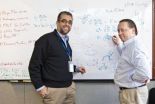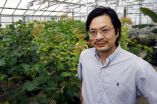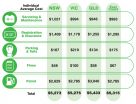(Press-News.org) Physicists have discovered a possible solution to a mystery that has long baffled researchers working to harness fusion. If confirmed by experiment, the finding could help scientists eliminate a major impediment to the development of fusion as a clean and abundant source of energy for producing electric power.
An in-depth analysis by scientists from the U.S. Department of Energy's Princeton Plasma Physics Laboratory (PPPL) zeroed in on tiny, bubble-like islands that appear in the hot, charged gases—or plasmas—during experiments. These minute islands collect impurities that cool the plasma. And it is these islands, the scientists report in the April 20 issue of Physical Review Letters, that are at the root of a long-standing problem known as the "density limit" that can prevent fusion reactors from operating at maximum efficiency.
Fusion occurs when plasmas become hot and dense enough for the atomic nuclei contained within the hot gas to combine and release energy. But when the plasmas in experimental reactors called tokamaks reach the mysterious density limit, they can spiral apart into a flash of light. "The big mystery is why adding more heating power to the plasma doesn't get you to higher density," said David A. Gates, a principal research physicist at PPPL and co-author of the proposed solution with Luis Delgado-Aparicio, a post-doctoral fellow at PPPL and a visiting scientist at MIT's Plasma Science Fusion Center. "This is critical because density is the key parameter in reaching fusion and people have been puzzling about this for 30 or 40 years."
The scientists hit upon their theory in what Gates called "a 10-minute 'Aha!' moment." Working out equations on a whiteboard in Gates' office, the physicists focused on the islands and the impurities that drive away energy. The impurities stem from particles that the plasma kicks up from the tokamak wall. "When you hit this magical density limit, the islands grow and coalesce and the plasma ends up in a disruption," says Delgado-Aparacio.
These islands actually inflict double damage, the scientists said. Besides cooling the plasma, the islands act as shields that block out added power. The balance tips when more power escapes from the islands than researchers can pump into the plasma through a process called ohmic heating—the same process that heats a toaster when electricity passes through it. When the islands grow large enough, the electric current that helps to heat and confine the plasma collapses, allowing the plasma to fly apart.
Gates and Delgado-Aparicio now hope to test their theory with experiments on a tokamak called Alcator C-Mod at MIT, and on the DIII-D tokamak at General Atomics in San Diego. Among other things, they intend to see if injecting power directly into the islands will lead to higher density. If so, that could help future tokamaks reach the extreme density and 100-million-degree temperatures that fusion requires.
The scientists' theory represents a fresh approach to the density limit, which also is known as the "Greenwald limit" after MIT physicist Martin Greenwald, who has derived an equation that describes it. Greenwald has another potential explanation of the source of the limit. He thinks it may occur when turbulence creates fluctuations that cool the edge of the plasma and squeeze too much current into too little space in the core of the plasma, causing the current to become unstable and crash. "There is a fair amount of evidence for this," he said. However, he added, "We don't have a nice story with a beginning and end and we should always be open to new ideas."
Gates and Delgado-Aparicio pieced together their model from a variety of clues that have developed in recent decades. Gates first heard of the density limit while working as a post-doctoral fellow at the Culham Centre for Fusion Energy in Abingdon, England, in 1993. The limit had previously been named for Culham scientist Jan Hugill, who described it to Gates in detail.
Separately, papers on plasma islands were beginning to surface in scientific circles. French physicist Paul-Henri Rebut described radiation-driven islands in a mid-1980s conference paper, but not in a periodical. German physicist Wolfgang Suttrop speculated a decade later that the islands were associated with the density limit. "The paper he wrote was actually the trigger for our idea, but he didn't relate the islands directly to the Greenwald limit," said Gates, who had worked with Suttrop on a tokamak experiment at the Max Planck Institute for Plasma Physics in Garching, Germany, in 1996 before joining PPPL the following year.
AUDIO:
David Gates and Luis Delgado-Aparicio discuss a solution they discovered that could eliminate a critical barrier to fusion.
Click here for more information.
In early 2011, the topic of plasma islands had mostly receded from Gates' mind. But a talk by Delgado-Aparicio about the possibility of such islands erupting in the plasmas contained within the Alcator C-Mod tokamak reignited his interest. Delgado-Aparicio spoke of corkscrew-shaped phenomena called snakes that had first been been observed by PPPL scientists in the 1980s and initially reported by German physicist Arthur Weller.
Intrigued by the talk, Gates urged Delgado-Aparicio to read the papers on islands by Rebut and Suttrop. An email from Delgado-Aparicio landed in Gates' in-box some eight months later. In it was a paper that described the behavior of snakes in a way that fit nicely with the C-Mod data. "I said, 'Wow! He's made a lot of progress,'" Gates remembers. "I said, 'You should come down and talk about this.'"
What most excited Gates was an equation for the growth of islands that hinted at the density limit by modifying a formula that British physicist Paul Harding Rutherford had derived back in the 1980s. "I thought, 'If Wolfgang (Suttrop) was right about the islands, this equation should be telling us the Greenwald limit," Gates said. "So when Luis arrived I pulled him into my office."
Then a curious thing happened. "It turns out that we didn't even need the entire equation," Gates said. "It was much simpler than that." By focusing solely on the density of the electrons in a plasma and the heat radiating from the islands, the researchers devised a formula for when the heat loss would surpass the electron density. That in turn pinpointed a possible mechanism behind the Greenwald limit.
Delgado-Aparicio became so absorbed in the scientists' new ideas that he missed several turnoffs while driving back to Cambridge that night. "It's intriguing to try to explain Mother Nature," he said. "When you understand a theory you can try to find a way to beat it. By that I mean find a way to work at densities higher than the limit."
Conquering the limit could provide essential improvements for future tokamaks that will need to produce self-sustaining fusion reactions, or "burning plasmas," to generate electric power. Such machines include proposed successors to ITER, a $20 billion experimental reactor that is being built in Cadarache, France, by the European Union, the United States and five other countries.
Why hadn't researchers pieced together a similar theory of the density-limit puzzle before? The answer, says Gates, lies in how ideas percolate through the scientific community. "The radiation-driven islands idea never got a lot of press," he says. "People thought of them as curiosities. The way we disseminate information is through publications, and this idea had a weak initial push."
PPPL, in Plainsboro, N.J., is devoted both to creating new knowledge about the physics of plasmas – ultra-hot, charged gases – and to developing practical solutions for the creation of fusion energy. Through the process of fusion, which is constantly occurring in the sun and other stars, energy is created when the nuclei of two lightweight atoms, such as those of hydrogen, combine in plasma at very high temperatures. When this happens, a burst of energy is released, which can be used to generate electricity.
INFORMATION:
Princeton Plasma Physics Laboratory is managed by Princeton University for the U.S. Department of Energy's Office of Science.
DOE's Office of Science is the single largest supporter of basic research in the physical sciences in the United States, and is working to address some of the most pressing challenges of our time. For more information, please visit science.energy.gov.
Scientists see solution to critical barrier to fusion
2012-04-24
ELSE PRESS RELEASES FROM THIS DATE:
Rice University student engineers automate limb lengthening for kids
2012-04-24
Another day, another four turns of the screw. That's just a part of life for people, primarily children, undergoing the long and difficult process of distraction osteogenesis, a method to correct bone deformities that leave one limb shorter than the other.
A team of Rice University undergraduates has invented a device they hope will make the process safer and easier.
In collaboration with Shriners Hospital for Children in Houston, the students came up with "LinDi," a self-adjusting, automated linear distractor. It eliminates manual manipulation of the screw with a motorized ...
Carfinance247.co.uk Data Suggests Used Car Buyers Are Downsizing
2012-04-24
Figures show that for the period Apr 2011 - Sep 2011, the average buying price of a used car was GBP8,730.45. For the period Oct 2011 - Mar 2012, this figure decreased to GBP7,697.25. This could suggest that motorists are being more cost-conscious in a still uneasy economy, says Director of carfinance247.co.uk, Louis Rix.
He says: "During the last 6 months, overall, it appears that our customers have been downsizing. This could be due to the fact they do not want the extra worry of having more debt hanging over them, or that they are being more budget-conscious. ...
That impulsive, moody preschooler may grow up to be a problem gambler
2012-04-24
Give me the child at 3 and I will give you the adult compulsive gambler. That is the striking finding of a new study in Psychological Science, a journal published by the Association for Psychological Science.
Based on tests of over 900 individuals beginning in toddlerhood, the study found that "people who were rated at age three as being more restless, inattentive, oppositional, and moody than other three-year old children were twice as likely to grow up to have problems with gambling as adults three decades later," says psychologist Wendy S. Slutske of University of ...
High levels of TRAIL protein in breast milk might contribute to anticancer activity
2012-04-24
Los Angeles, CA (April 23, 2012) The benefits of breast milk are well known, but why breastfeeding protects against various forms of cancer remains a mystery. A new study in the Journal of Human Lactation (published by SAGE) found high levels of cancer-fighting TNF-related apoptosis inducing ligand (TRAIL) in human milk, which might be one source of breast milk's anticancer activity.
Researchers took samples of colostrum, the first milk available to newborns, and of mature breast milk from new mothers. Researchers then obtained samples of blood from healthy women, and ...
Animated characters keep it real in teen violence prevention videos
2012-04-24
PHILADELPHIA (April 23, 2012)--- Briana and Damon could be the kids up the block. Briana does well in school and wants to follow in her sister's footsteps to college. Damon works hard at an after-school job in a local barbershop. They hang out with friends and try to stay out of trouble.
But Briana and Damon have a mission. Voiced by Philadelphia teens, they are a pair of digitally animated street-smart characters with a Facebook page aimed at reducing urban youth violence. Working with West Philadelphian residents who are members of the Philadelphia Area Research Community ...
Simlock Remote Server Goes BIG, the Biggest Samsung Software Update of 2012. 70+ New Hot Models Added for World First Unlocking / Unfreeze Service
2012-04-24
Simlock Remote Server is going BIG with this latest super-hot release adding more than 70 new models. Most of the new models are Samsung phones, some of the hottest new models are: Samsung I9020, I9220, I717 (all versions no rooting needed), I927 (save unlocking no damaged IMEI!), I997 (world first), Galaxy Tab (almost all versions 7.0 to 10.1 inch versions), Galaxy Mini 2 (S6500 - world first), T859, T989 and many more. Also added 631 new PRD's for Blackberry unlocking, 6 new Huawei models and 11 new ZTE models.
The Samsung Remote Client software is the biggest Samsung ...
Researchers find mechanism that gives plants 'balance'
2012-04-24
When a plant goes into defense mode in order to protect itself against harsh weather or disease, that's good for the plant, but bad for the farmer growing the plant. Bad because when a plant acts to defend itself, it turns off its growth mechanism.
But now researchers at Michigan State University, as part of an international collaboration, have figured out how plants can make the "decision" between growth and defense, a finding that could help them strike a balance – keep safe from harm while continuing to grow.
Writing in the current issue of the Proceedings of the ...
Queensland - The Most Expensive State to Run Your Car
2012-04-24
The annual cost of running your car is higher in Queensland than both NSW and Victoria, according to the new Bingle Cost of Motoring Index launched today.
Bingle spokesperson Melanie Vine said the reason for this is petrol, as the average cost is higher and Queenslanders cover more ground.
"On average, Queenslanders pay $411 more for petrol each year compared to New South Wales drivers," she said.
"Before you add petrol, Queenslanders pay less for fines, parking and tolls compared to Victorians, or NSW drivers' generally higher rego, maintenance ...
Brain surgery for epilepsy underutilized
2012-04-24
Ten years ago, a landmark clinical trial in Canada demonstrated the unequivocal effectiveness of brain surgeries for treating uncontrolled epilepsy, but since then the procedure has not been widely adopted—in fact, it is dramatically underutilized according to a new study from the University of California, San Francisco (UCSF).
The study, published this month in the journal Neurology, showed that the number of Americans having the surgery has not changed in the decade since release of the effectiveness study, though surgical treatment is now uniformly encouraged by neurology ...
Leeches are DNA bloodhounds in the jungle
2012-04-24
Copenhagen Zoo and University of Copenhagen have in collaboration developed a new and revolutionary, yet simple and cheap, method for tracking mammals in the rainforests of Southeast Asia. They collect leeches from tropical jungles, which have been sucking blood from mammals, and subsequently analyse the blood for mammal DNA. By using this method, the researchers can get an overview of the biodiversity of the mammals without having to find them. The groundbreaking results are to be published in the prestigious scientific journal Current Biology.
"It is not unusual that ...





